Encouraging Trends to Embrace for Path Forward at City’s Specialized High Schools

Mayor and Chancellor have major decisions to make (photo: Ed Reed/Mayor's Office)
While our schools are shut down because of the coronavirus, recent good news points to successful efforts to improve the ethnic diversity of the city’s specialized high schools -- Brooklyn Tech, Stuyvesant, Bronx Science, and five others.
At the end of May, the New York City Department of Education issued its report on the Discovery Program. Created over 50 years ago to improve admissions for black and Latino students, it had fallen into complete disuse, except at Brooklyn Tech. To be eligible, students must score a bit below the cutoff on the specialized high school exam (SHSAT) and qualify under federal anti-poverty guidelines. Those who enter the Discovery Program take enhanced educational courses over the summer to better prepare them for the rigors of the specialized high school curriculum.
Several years ago, the Brooklyn Tech Alumni Foundation, which I head, advocated for the reintroduction of Discovery but with a tweak to admit more black and Latino students by focusing eligibility on underrepresented middle schools. Because Asian-American families in New York City have the highest poverty rate, only basing eligibility on economic status did not appreciably enter black and Latino students.
The number of Discovery seats this year is 800 compared to 250 in 2018. This year, 470 Discovery invitations went to black and Latino students, compared to only 278 last year. This is a significant increase over what existed before the Department of Education accepted our suggestion. Even more exciting, now there are first-time admissions from middle schools previously not represented among the student bodies of the specialized high schools.
While black and Latino Discovery admissions greatly increased, Schools Chancellor Richard Carranza poo-poos the achievement: He says revamped Discovery “does not move the needle enough,” which is classic Carranza. He refuses to say that anything short of eliminating the SHSAT is good enough, no matter how good.
For another example, he testified at the City Council that he disfavored expanding the city’s Dream test prep program, which also improves the specialized high school admission rates of black and Latino students. He said it “would not be a good use of resources,” although he blames private test prep for the demographic disparity in admissions.
Here again, Carranza is wrong. For the past six years, the Brooklyn Tech Alumni Foundation has run a pilot program combining focused outreach to underrepresented Brooklyn middle schools with two years of educational enrichment and free test prep. Sixty percent of participants were accepted at a specialized high school. Most were black, Latino, or female, another underrepresented group in our specialized schools.
The students from our first cohort are now attending Binghamton, Brown, CCNY, Cornell, Howard, Macaulay Honors, Middlebury, Northeastern, Rutgers, SUNY Buffalo, UCLA, and Michigan. This program should serve as a model for the city to roll out an effective affirmative action program based at each of the specialized schools.
Several years ago, the state allocated $1.75 million to the New York City DOE to launch similar programs at the specialized schools. At Tech, where we got a dedicated grant of $250,000, we doubled the size of our program. For the rest, the DOE did nothing.
Since arriving in New York, Carranza has repeatedly criticized the specialized high schools because the percentage of black and Latino students attending these schools is too low. He ignores that 20 years ago, the enrollment of black and Latino students at the specialized schools was much better. Back then, the Education Department had enhanced educational opportunities like gifted elementary programs and junior high SP classes in the schools serving heavily black and Latino communities.
Carranza should recognize that eliminating the test does nothing to improve the education in our schools for the children he wants to help. To restore equity in our specialized schools, he needs to improve the coursework offered in these communities while supporting innovative and successful efforts to promote diversity now. The models are here.
Our schools will eventually reopen, but it is now time for the Chancellor to recognize that he should lead, not criticize. He owes it to all the city’s children but especially to the students in the black and Latino communities.
***
Larry Cary is a Manhattan lawyer and the President of the Brooklyn Tech Alumni Foundation.
***
Have an op-ed idea or submission for Gotham Gazette? Email This email address is being protected from spambots. You need JavaScript enabled to view it.
Hurricane Season Could Delay COVID-19 Recovery: Here's How We Prepare
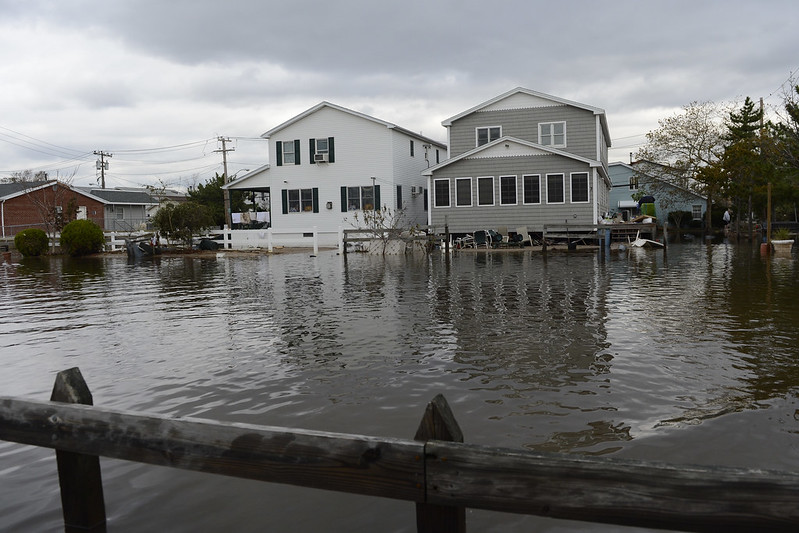
It's time to better prepare (photo: governor's office)
New York has faced its share of disasters, and each one seemed impossible and unprecedented until it actually happened. 9/11, Superstorm Sandy, and now COVID-19 each took a dramatic toll on our social and physical infrastructure, the state’s economy, and our very way of life.
We always recover, but we must break the cycle of rebuilding and plan for future risk instead. Any threats must be taken seriously as many communities are already overextended and strained. Hurricane season starts next month, and we need flood policy reforms at a federal level to ensure an already bad situation doesn't get worse.
The ongoing battle to contain COVID-19 coupled with the upcoming threat of hurricane season is a dangerous combination. Early forecasts indicate this Atlantic hurricane season may be worse than usual, which would have a devastating impact on our already fragile infrastructure. Flooding has massive and damaging impacts: from roads and public infrastructure to our homes to our workplaces. We saw this during Superstorm Sandy where New York’s infrastructure and economy took a massive hit. Sadly, our infrastructure is no better prepared now than it was then. When you factor in the consequences COVID-19 has already had on our state and sources of revenue, New York cannot handle another blow so soon.
Without comprehensive federal action to reduce flood risk, our current disaster relief and recovery policies will continue to allow and even incentivize risky development, leaving existing and future infrastructure and our communities in peril. As local businesses begin to reopen in a post-COVID world, we must ensure that they can remain open if a storm hits by investing in resilient infrastructure. Our small businesses rely on well-functioning infrastructure, and our community must advocate for an updated flood-ready requirement that is smart and forward-thinking. There are certain steps we and our policymakers must take that are critical to New York’s survival and recovery.
Support the 2020 Environmental Bond Act
First, we encourage New Yorkers to vote to approve the environmental bond act on the ballot for the general election this fall, which would be hugely advantageous for New York’s economy and environment. Despite facing challenges from COVID-19, Governor Cuomo and the Legislature advanced the bond act, known as the Restore Mother Nature Bond Act, which would provide $3 billion for a wide range of environmental protection programs and initiatives, including flood mitigation; habitat restoration; combating climate change; and clear water projects, while creating critical jobs.
Invest in Resilient Infrastructure
Our state’s economy is also directly tied to environmental resilience and sustainability. Every $1 invested in disaster mitigation saves $6 in flood damage costs. Our infrastructure across the state has trouble handling heavy rains, let alone massive storms, and in the current climate we must keep in mind that it is in our best economic interest to invest in a resilient foundation. By building or rebuilding with resilience in mind we can protect communities and save money.
Disclose a Property’s Flooding History
It is imperative to equip consumers with crucial information on properties they intend to buy or rent, like the property’s flooding history. If we make the disclosure of this information mandatory, people will be more prepared when making important and life-changing financial decisions, such as buying a house or renting an apartment, and therefore not be surprised by the massive financial upheaval that is caused if your living or working space is completely flooded. New Yorkers are having trouble making rent and mortgage payments now, and aren’t able to save up to fix property damage due to flooding.
Reform the NFIP
The National Flood Insurance Program (NFIP) is another key policy that helps protect our communities. However, it has not been updated to address locations that are flooding more frequently or are still handling damage from previous floods. The program remains $20 billion in debt. Congress must not only fund and reform the NFIP but invest in long-term resilience through FEMA’s Building Resilient Infrastructure and Communities program and the development of a revolving loan and grant program to fund risk reduction.
Through updates to NFIP, we can also promote and protect our existing ecological systems. Investing in nature-based solutions is crucial to encouraging flourishing wildlife while protecting our local communities.
All of these changes are economically smart and environmentally crucial, even more so as we begin to feel the aftershocks and recover from the total upheaval of COVID-19. We urge New York voters to approve the environmental bond act this fall and Congress to reform NFIP, protect our infrastructure and wildlife in New York, and provide a more stable economic pathway for the future.
***
Julie Tighe is President of the New York League of Conservation Voters, a nonpartisan, statewide environmental organization that fights for clean water, healthy air, renewable energy, and open space. On Twitter @JulieTighe17 & @NYLCV.
***
Have an op-ed idea or submission for Gotham Gazette? Email This email address is being protected from spambots. You need JavaScript enabled to view it.
Good News and Bad News on the State of Homelessness in New York City
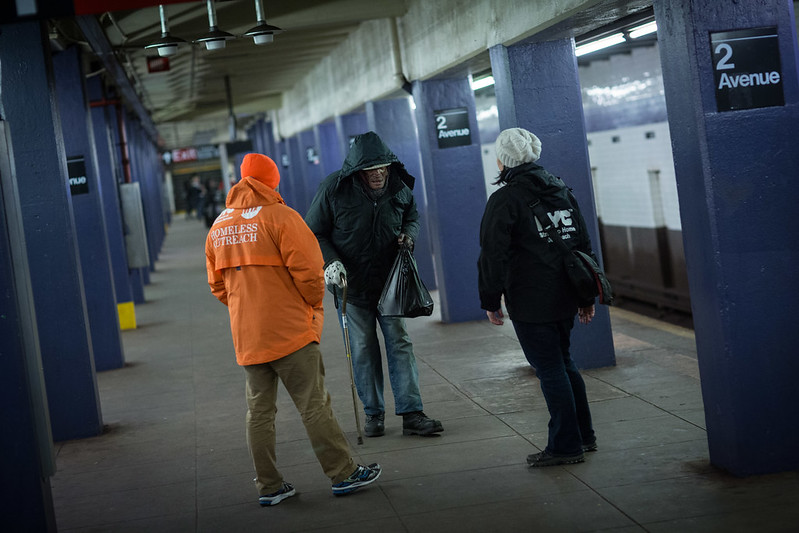
Homeless outreach workers approach a person in the subway (photo: Michael Appleton/Mayor's Office)
As the city has been focused on the coronavirus crisis the attention concerning homeless people has been the growing number of them in the subway system, it is time we examined what is happening within the vast and very expensive shelter system that is costing $2 billion a year.
As a former Deputy Commissioner with the New York City Department of Homeless Services I can tell you that there are three types of shelters. There is the single adult system, the adult family system, comprised of two adults without children, and the families with children system.
According to the latest report from the Department there are nearly 57,000 total individuals residing in the shelter system, 37,000 are adults and 20,000 are children.
There is some good news: the number of families with children is down 7% from the same time last year and over the past six years this number is nearly even (now: 11,250; then: 10,900). There is less good news in the adult family shelter system where we have 2,416 people residing now compared to 2,495 at the same time last year. While that number is down slightly from a year ago, the present number is 28% higher than it was six years ago.
And now for the bad news: the number of single adults presently residing in the shelters is 17,200 (12,700 men and 4,500 women). This number is up by 8% over last year at this time and up an incredible 70% in the last six years.
The city is spending an average of $125 a night to house single adults, but this number, which is already the result of a high number of clients residing in overflow hotel rooms, is growing rapidly. The expense will skyrocket after the city finishes paying for the additional 7,000 rooms it is now renting to stop the spread of the coronavirus, which might not have been necessary, to such an extent, if the shelter system was not so severely overcrowded. Individuals residing in congregate shelters are being moved to hotel rooms, often two to a room, in the effort to limit the spread.
If you are wondering why the single population is up by 70% over six years, during which time the city has had a very low unemployment rate, one of the reasons is that the state has been dumping 4,500 newly-released prisoners directly into the shelter system each year. This transfer of prisoners from the care of the state into city shelters must be curtailed immediately. The state must do a better job of discharge planning and establishing a large system of halfway houses.
The average length of stay for those in the single adult system is up significantly and so after the pandemic the city should consider going back to the Work Experience Program, where healthy clients would be required to do 20 hours a week of community service such as cleaning a public park or the grounds of a public housing development.
Another way to reduce the number of single adults in the shelter system is to set up an eligibility review process similar to the one used in the family system. New clients should be questioned as to whether they have any other alternative living arrangements and if so be denied entry, which is reserved for those who are without any other means of shelter. The Bloomberg administration attempted to do this some 10 years ago but the City Council shot it down. However, the times have certainly changed with this terrible virus and its fallout, whereby a million New Yorkers have or are estimated to lose their jobs, and city government is expecting a drop of roughly $9 billion in tax revenue between this fiscal year and next. As a result, Mayor de Blasio has talked about laying off essential city employees and slashing billions in city spending.
Another efficient and very effective way to reduce the homeless population in unacceptable shelter circumstances is to provide supportive housing to single adults who need it. I ran two supportive housing programs where shelter residents have an apartment with social services. Unfortunately, the city and state are at a 14-year-low on making such placements. The inability of Mayor de Blasio and Governor Cuomo to work together on a new “New York-New York agreement, like their predecessors did three times, has resulted in many units being promised but few actually funded and opened. In fact, ten years ago twice as many single adults living in shelters were placed into supportive housing as compared to now.
As COVID-19 continues to ravage our population, it is ravaging our city economy and budget, and we must not continue to conduct business as usual when it comes to spending on homeless services. We must think differently and try better ways to meet the needs of those in need.
***
Robert Mascali is a former Deputy Commissioner at the New York City Department of Homeless Services and Vice President for Supportive Housing at Women in Need.
***
Have an op-ed idea or submission for Gotham Gazette? Email This email address is being protected from spambots. You need JavaScript enabled to view it.
3 Potential Outcomes SCOTUS Might Reach on DACA
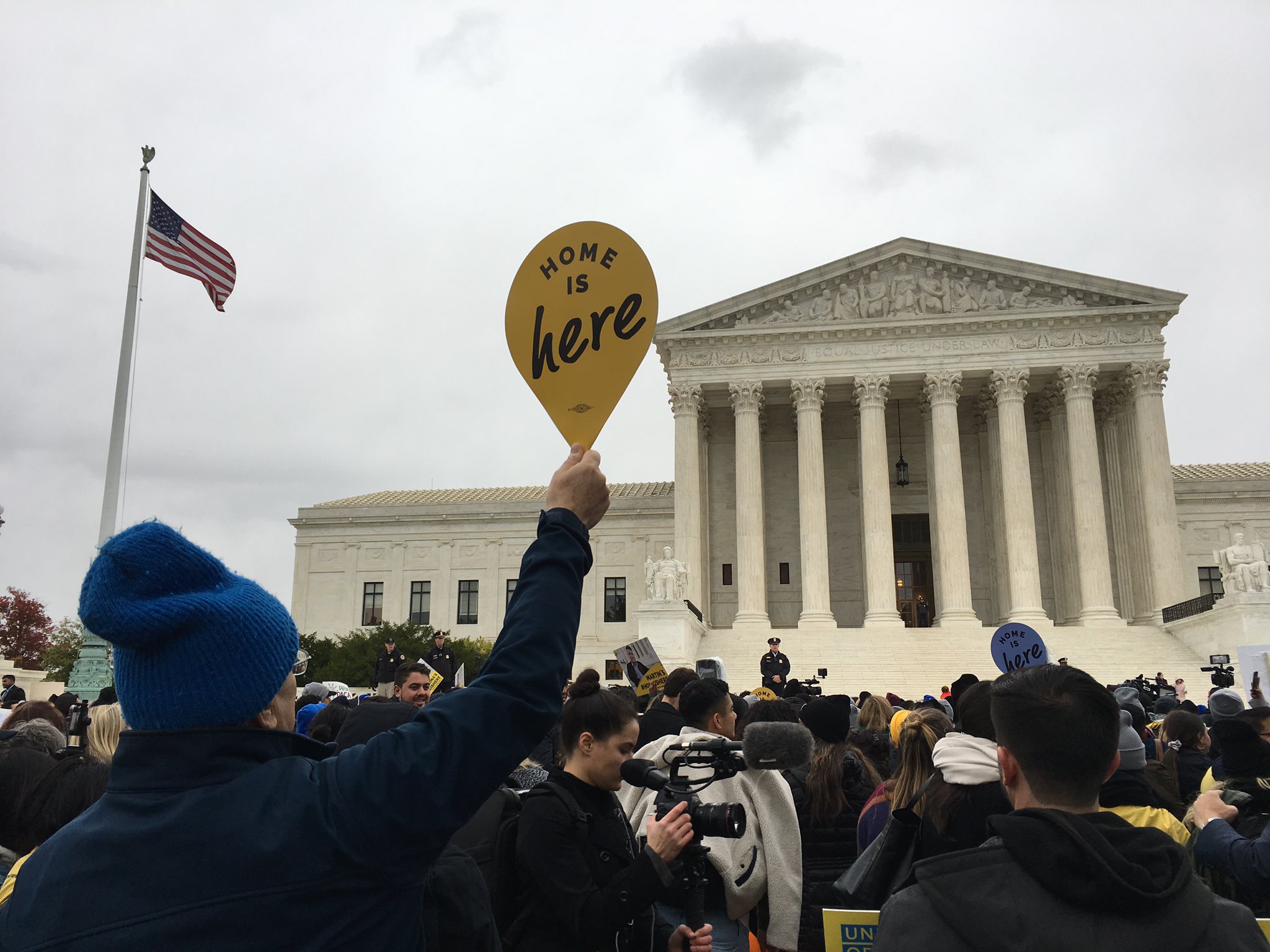
SCOTUS will soon rule on DACA in some way (photo: @afsc_org)
Scores of facebook messages and emails fill my inbox each day from immigrant youth protected under the Deferred Action for Childhood Arrivals (DACA) program — the Obama-era initiative that provided work authorization and protection against deportation for undocumented immigrants brought to the country as children.
They ask the same question: what will the U.S. Supreme Court decide on DACA.
Any day now, the nine justices will answer this question that will decide the fate of 650,000 young people shielded under the program, with an estimated 30,000 in New York City. Before we turn to the potential outcomes, however, let’s first lay out what the Court is actually ruling on.
The Court is focusing on two questions in Trump v. Regents of the University of California et al. (the DACA case): whether the Court has authority to review President Trump’s decision to end DACA, and, if so, whether he followed proper procedures in terminating DACA.
The legal path the Court takes to reach its conclusion will be as important as what it ultimately concludes. Every footnote, word, and punctuation will be critical. There is, however, legal guidance that projects three potential outcomes:
SCOTUS: We don’t have authority over Trump’s decision to terminate DACA.
This means that a President has almost full control over DACA. The worst, and unlikely, scenario here would see the United States Citizenship and Immigration Services (USCIS) dismantling the program by immediately cancelling existing work permits and invalidating pending renewals.
Depending on any arrests or criminal record, Immigration Customs and Enforcement could detain and begin deportation proceedings against the person who is no longer protected by DACA.
Control over DACA could also mean that President Trump would use it as leverage for legislative bargaining. He would likely direct USCIS to continue work permits and deportation relief until he bargains with Congress for a deal, e.g. border wall in exchange for some form of legal status for Dreamers. Anything is possible in an election year.
Another scenario under this decision would also allow a potential Biden administration to reinstate DACA — maybe even create a broader DACA program that would allow international travel and facilitate a path to citizenship.
SCOTUS: We have authority and Trump’s decision to terminate DACA is unlawful.
Under this better scenario, the Administration would need to restart the entire program. Depending on what precisely the Court considers the “lawful way,” Trump could then correctly proceed — like following the steps of the Federal Administrative Procedure Act — to end the program.
According to the Government Accountability Office, the average time a federal agency takes to change agency rules is about four years. In the meantime, USCIS could allow renewals, new applications, and even foreign travel.
If the ruling is that the President lawfully ended the program, then the Court will revert discretion to the President on how and when it can end the program. The Court could place restrictions like allowing work permits to continue until they expire or at another stated expiration date (e.g. end of the national state of emergency due to COVID-19).
DACA is itself unlawful
Finally, if the Court concludes that DACA itself is unlawful, then the program will be terminated without the President taking further steps. Once again the Court could indicate how and when the program will be rolled back.
Living at the fault line of immigration policy has filled the lives of thousands of immigrant youth with uncertainty. I know how that feels. Still, having come out of the shadows, I know that Dreamers will not go back.
Their home is here. And they are here to stay.
****
Cesar Vargas is New York's first undocumented attorney and a national advocate for immigration reform. On Twitter @Dreamer_Esq.
***
Have an op-ed idea or submission for Gotham Gazette? Email This email address is being protected from spambots. You need JavaScript enabled to view it.
As Courts Reopen, Threat of ICE Returns: State Lawmakers Must Protect Our Neighbors
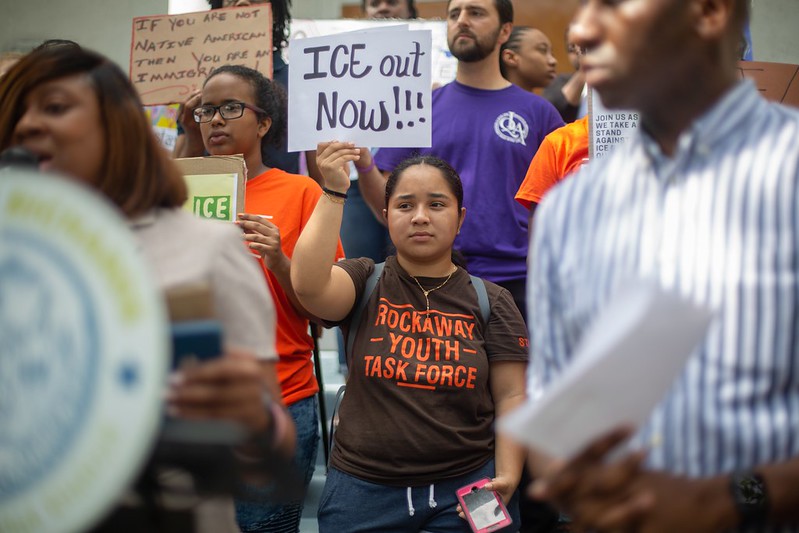
As courts in NY reopen, the role of ICE will be top of mind for many (photo: John McCarten/City Council)
Courthouses in 30 upstate New York counties have begun the gradual process of restarting the state’s legal system. The pandemic has highlighted the urgent need for due process and just how critical access to justice is for New York’s most vulnerable communities. There remain, however, significant barriers for many who desperately need their day in court.
For years, ICE has preyed on non-citizens in and around our courthouses, using fear and intimidation to limit access to justice for our communities. The Protect Our Courts Act would help ensure that all New Yorkers feel safe to access the courts by preventing ICE agents from detaining people in or around courthouses unless they have a signed judicial warrant.
Lawmakers in Albany must make the Protect Our Courts Act a priority if we are going to make the promise of equal justice under the law a reality in this time of crisis. Without this vital protection, we are likely to see a surge in ICE arrests that will effectively shut many of the most vulnerable New Yorkers out of the courts and heighten the risk of contagion for those detained. The Immigrant Defense Project (IDP) tracks ICE raids throughout the state, and in the first 11 weeks of 2020, raids in New York City increased 400% compared with the same period last year. When these arrests ramp up again, and they will, the same communities hardest hit by COVID-19 will have to endure another wave of attacks, mourning, and lives disappeared.
ICE has already used the courthouse to trap immigrants during the current crisis. On March 13, as President Trump declared a National Emergency, Mr. RC, a client of The Bronx Defenders, appeared in state court in Poughkeepsie. Despite the mounting pandemic and the deployment of state and federal resources to try to contain the virus and protect public health, six ICE officers entered the courthouse, defying Office of Court Administration rules promulgated last year, waited for Mr. RC outside the courtroom doors, and arrested him as he left his court appearance. None of the officers wore gloves, masks, or any other protective gear. ICE then detained Mr. RC at the Orange County Jail, increasing the likelihood of exposure and separating him from his fiancee and one-year-old as the worst period of the pandemic was just beginning.
Mr. RC’s experience is not an aberration. The Bronx Defenders has represented hundreds of individuals arrested under circumstances that demonstrate ICE’s disregard for the health, safety, and, indeed, the humanity of immigrants in New York. The tremendous health risks posed by detention centers have been well-documented. Detained immigrants have been holding hunger strikes, protesting, and filing lawsuits calling on ICE to end unnecessary and harmful detention. The last place anyone should be in the midst of this pandemic is a cage. At this critical moment, New York should embrace legislation that would limit ICE’s ability to pull more New Yorkers into its dragnet.
It is hard to imagine a worse time to punish and endanger immigrant New Yorkers. Every ICE arrest, detention, and deportation takes someone away from communities that have been pushed past the breaking point. The death rate for black and Latino people in New York City has been twice the rate for white people, and essential workers most at risk are disproportionately likely to be women, immigrants, black, and Latino. As people vanish from the neighborhood, loved ones are left turning over survival and grief in their hands as refrigerated trucks full of the deceased sit in parking lots nearby.
The Protect our Courts Act already has majority support in both chambers of the New York State Legislature. Now more than ever we cannot let ICE stand in the way of full access to public services, rights, and remedies, including those available at the courts, such as orders of protection, fighting evictions, seeking child support, and defending oneself against criminal charges. When ICE’s intentions to use our courts as a lure to detain immigrants at the outset of a pandemic are so clear, we must not wait to see how ICE will strike next before we act.
***
Mizue Aizeki is the deputy director of the Immigrant Defense Project. Rosa Cohen-Cruz is the Policy Counsel to the Immigration Practice of the Bronx Defenders. On Twitter @ImmDefense & @BronxDefenders.
***
Have an op-ed idea or submission for Gotham Gazette? Email This email address is being protected from spambots. You need JavaScript enabled to view it.
Trump Continues His Assault on Independent Oversight and Rule of Law
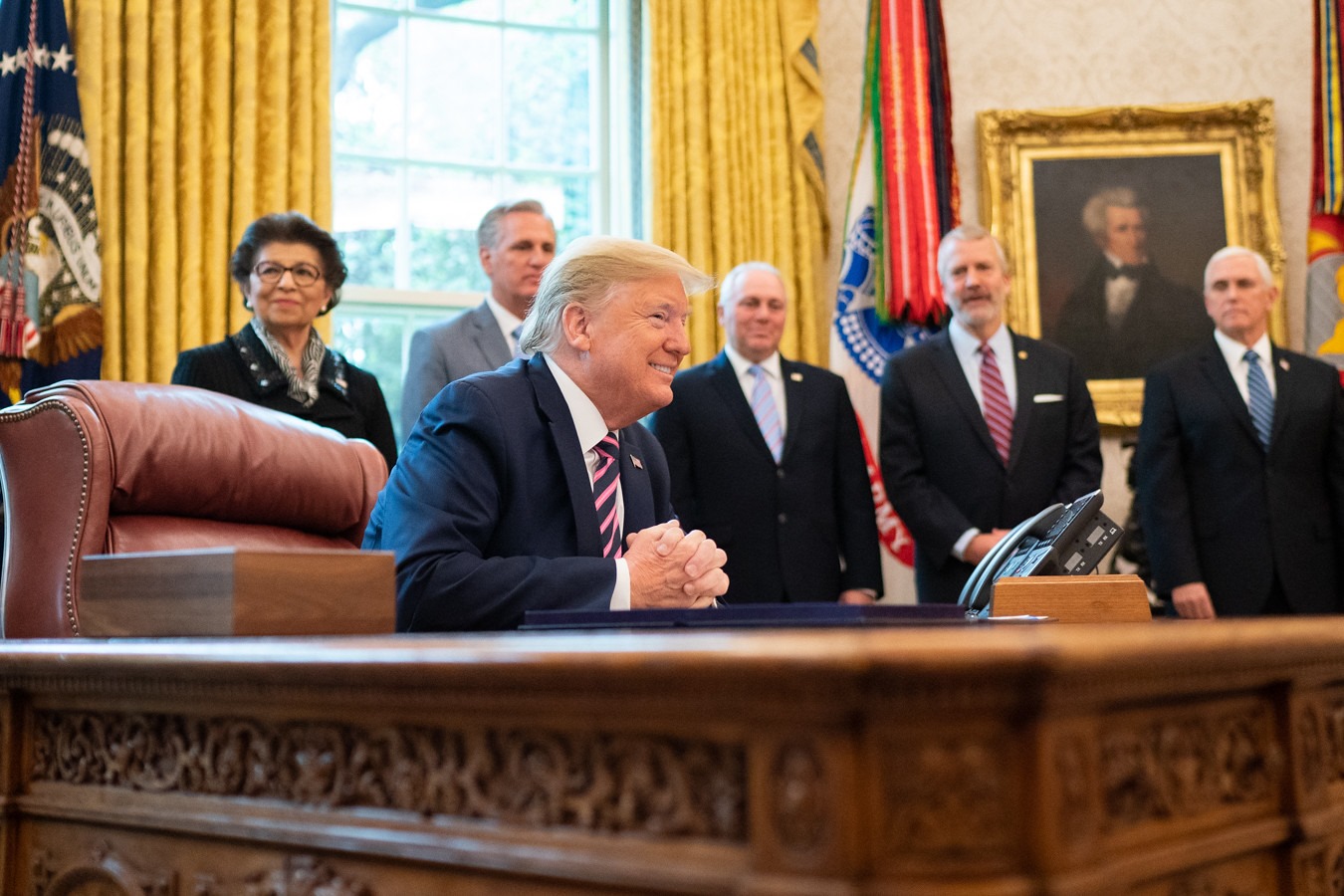
President Trump (photo: White House)
In late April, I wrote a guest column regarding President Donald Trump’s firing of a federal Inspector General, threats to other IGs and the rule of law, and how New York City’s inspectors general system is a model, with no city IG removed for doing their job. Over the last weeks Trump has escalated his war on the nation’s watchdogs as a way of “draining the swamp,” or, in reality, removing independent oversight of him and his administration.
The following is an update of Trump’s attack on the independence and integrity of IGs after unsupported firings of three inspectors general and a political juggling act removing another IG. A total of four federal IGs are gone, one of which Trump first chastised before firing. Now, all federal IGs must be looking over their shoulders at a lurking president.
The mission of all inspectors general is to provide independent, objective oversight to improve the integrity, accountability, and performance of our government and to improve government programs, in part by recommending corrective actions and promoting high standards.
The 1978 Inspector General Act, supported by six Democratic and Republican presidents, mandates the importance of independent oversight. Since April 3 President Donald Trump did a spring IG housecleaning, ending independent oversight with retaliatory firings of three IGs after publicly flogging one and replacing another.
All four IGs felt Trump’s wrath while protecting our nation. An abuse of presidential power unheard of in 42 years, now rocking our government to the core with threats and suppression of our nation’s watchdogs from ferreting out waste, cronyism, fraud, and corruption. It is an egregious assault on good government, integrity and independence, especially after Congress appropriated trillions to fight a pandemic.
On May 15, State Department Inspector General Steve Linick was fired. Linick was reportedly investigating Secretary of State Mike Pompeo for having a State political appointee perform personal tasks for Pompeo and his wife. (In New York City, that’s a violation of the City Charter.)
Additionally, at Congress’ request, Linick was investigating an $8 billion arms deal, bypassing Congressional review, with Saudi Arabia.
These two investigations were halted by Trump’s unfounded firing, as urged by Pompeo, the target of the IG’s investigation. Pompeo said of Linick’s termination, “Frankly, should've done it some time ago.” Trump ratified this manipulation, incredibly saying, "Never even heard of Linick," but fired him because Pompeo “asked me to terminate him” and Linick “no longer had my full confidence.”
This is not the first time Trump used the ridiculous 'never heard of him' response when he himself was linked to wrongdoing and clearly knew the individual involved.
For instance: Lev Parness, Rudy Giuliani’s crony tied to the Ukraine scandal; Gordon Sondland, Ambassador to the European Union, a major donor to the Trump inauguration committee and a key impeachment witness; and sex trafficking kingpin Jeffrey Epstein; among others.
In an obvious move to protect Pompeo and derail Linick’s investigations, Trump named Stephen Akard, an ambassador closely aligned to Vice President Mike Pence, as Linick’s IG replacement. It’s unclear how well Trump knows Akard.
Although Linick is the latest to be axed, the IG massacre started on April 3 with the firing of Trump’s own appointee, Michael Atkinson, who was Inspector General at the Office of the Director of National Intelligence, for disloyalty. Atkinson, investigated the whistleblower’s complaint alleging Trump pressured the Ukraine president to investigate presidential candidate Joe Biden’s son. Atkinson was fired for doing his job and not revealing the whistleblower’s identity.
Next was Christi Grimm, Health and Human Services’ Deputy Inspector General, who reported coronavirus shortages and testing delays at our nation’s hospitals. Trump loudly criticized Grimm, calling the IG’s report “fake” and insinuating, without support, Grimm’s report was politically motivated. Trump fired her.
Then there is Glenn Fine, the Department of Defense’s acting Inspector General, who was selected by a Council of IGs, based upon Fine’s credentials and DOD title, to serve as Congress’ coronavirus special IG, wisely established by Congress in the $2.2 trillion CARES Act to ensure funds are not misspent for coronavirus relief efforts. Evidently, alarm bells went off at the White House with this oversight temporarily vested in a special IG not appointed by the president.
Corrective action was required.
In a deft sleight of hand in the middle of the pandemic, Trump removed acting DoD IG Fine and replaced him with Sean O’Donnell, making O’Donnell the Council’s selection as the temporary coronavirus special IG since the appointment was tied to the DoD post, not the person. Additionally, O’Donnell continues to serve in two acting positions as Trump’s EPA IG and DoD IG.
Trump nominated Brian Miller as the permanent special inspector general for pandemic response – replacing O’Donnell – and the Republican majority Senate committee voted 14-11, recommending Miller’s confirmation to the full Senate.
Independence was the key watchword at Miller’s Senate confirmation hearing. Trump’s pick, currently a White House lawyer and formerly one of Trump's impeachment attorneys, loudly raised a number of Democratic senators’ voices, notwithstanding Miller, as Linick, Fine and Grimm, served in both Democratic and Republican administrations as a federal watchdog.
Miller promised the senators he wouldn’t “bend” for anyone in Trump’s orbit if confirmed. The Democratic senators were doubtful, as they and we should be.
Notwithstanding this whirlwind presidential power game of IG musical chairs, the burning question is: will Trump loyalists O’Donnell and Miller (once the Senate confirms him) aggressively investigate whether the coronavirus trillions are properly spent?
If they do, O’Donnell will be out of his acting Trump jobs, and for Miller, private practice looms.
What is critically at stake with Trump's political firings is the independence of inspectors general, which Trump ended by breaching the Act's clear intent.
Checking and balancing a presidential abuse of power rests with the Congress. Miller’s Senate confirmation must be used as the means to raise the issue of how to protect IGs from reprisals by a disgruntled and circling president. Unfortunately, politics will prevail, and Miller and other Trump IGs will be confirmed with no safeguards enacted.
Result: good government will suffer deeply -- it already has.
***
Arnold N. Kriss is an attorney in private practice, and a former NYPD Deputy Commissioner for Trials and Brooklyn Assistant District Attorney. On Twitter @ArnieKriss.
***
Have an op-ed idea or submission for Gotham Gazette? Email This email address is being protected from spambots. You need JavaScript enabled to view it.
I Survived COVID-19; It Proved the Queens Hospital Crisis
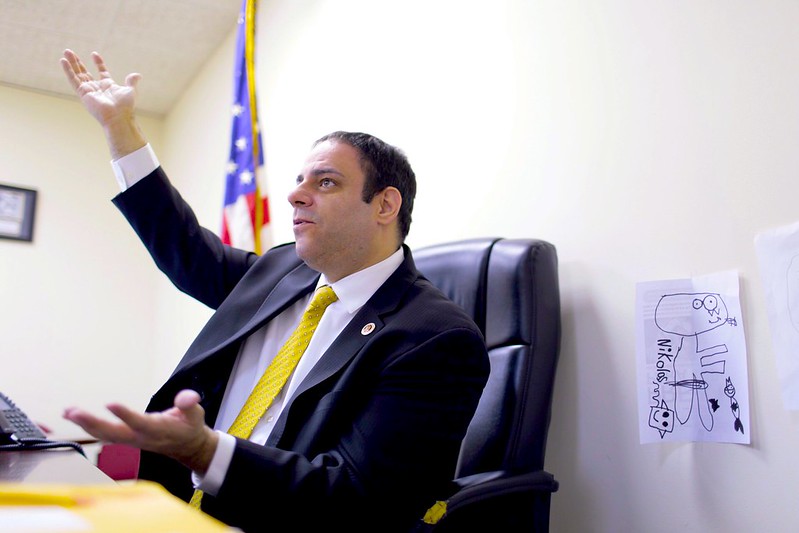
Council Member Costa Constantinides (photo: New York City Council)
The whole thing happened so fast. One minute my son and I are playing video games and the next he and my wife, who struggles with diabetes and is in renal failure, rush out the door to her mother’s apartment. So much has changed for my family and our community in the weeks since my fever first hit 102 degrees. However, throughout this experience, one thing remains shockingly clear: we need more hospitals in Queens and to reimagine how people access health care in the World’s Borough.
Queens is the epicenter of the epicenter. All of us — from those who fell ill, to our healthcare workers, to those whose anxiety was worsened by being locked in for weeks — will no doubt carry physical and mental scars forever. My family’s hellish few weeks of multiple trips to the hospital is the story of so many residents of Queens, where well over 56,000 positive cases are among the most of any county in New York State. And in many ways my wife and I are lucky.
Still, I’ll admit it’s been hard not to be angry at the fact that Queens has lost five hospitals over the last 20 years. You cannot refute that the loss of hundreds of hospital beds over a two-year period in the late 2000s is part of the reason why so many people have died — many at home surrounded by panicked relatives unsure of what to do. About one-sixth of all New York State’s positive COVID-19 cases have been in Queens, a borough of 2.3 million people serviced by eight hospitals. It doesn’t take a math expert to see this was a doomed situation from the get-go. Because we didn’t have a plan sooner to flatter the curve, a tidal wave crashed down on our already worn-out health-care system -- and we couldn’t even brace for it.
This virus is an enigma even the world’s most brilliant minds are still working to crack. Not understanding the symptoms has led many of us to overthink every cough. Panic reigned supreme. Was I cold because the fever is back or because the window was open? Do I have to go to the hospital for burning my hand on the radiator, potentially spreading this to more people? Why did I feel better one day and twice as worse the next? It took weeks to accept the fact that I cannot unpack this problem, determine the cause, and find a creative solution. I could not legislate away the coronavirus.
The best I can do is to get better, then work like hell to make sure other people can solve this. Once we’re fully on the other side of this curve the first order of business must be to build new hospitals in Queens. We lacked the capacity to properly observe all COVID-19 patients, let alone treat any other illnesses or injuries people experienced during the apex. The isolation of this virus is the cruelest part, as it takes away the support system on which we all rely. Many sat at home like I did, frightened by their symptoms, left to stare at their son’s toys on the floor or their wedding photo on the wall and wonder, Will I ever see my family again?
New hospitals shouldn’t be just about saving the lives of people who walk into them. It’s about those who run them, too. Our health-care workers are heroes, but they’ve also borne the burden of a pared down medical system. They work tiring shifts without enough protective equipment. Because we cannot hold our loved ones’ hands as they succumb to this virus, these heroes provide those last moments of comfort. Many are stoics who shrug it off as “part of the job,” but we know they are silently fighting severe emotional distress. A memorial to them is overdue. But the greatest tribute we can make is to build the infrastructure, both in more capacity so they can do their best job possible the next time a pandemic strikes and in support so they won’t be coming home to deal with tragedy alone.
I first ran for office seven years ago on the promise to support Mount Sinai Queens, which in 2004 didn’t have the specialized resources to treat my father for an aneurysm. He died in transit to the closest Manhattan hospital that could. My hope was that no one would have to face the choice I did: let him die here in Queens or run the risk of crossing the bridge. I thought it was a major victory when we funded a state-of-the-art stroke center there. I've been proud to support and partner on this vision of growth at Mt. Sinai. In hindsight, however, it was a drop in the bucket. So much more is needed now.
Everyone should have the ability to go to a hospital. The hard work to get out of this crisis has only begun. It will be all for nothing unless we fight for greater hospital capacity. I owe it to the countless people who made sure our son still has his mom and dad.
***
Costa Constantinides is a New York City Council Member and candidate for Queens Borough President. On Twitter @Costa4NY.
***
Have an op-ed idea or submission for Gotham Gazette? Email This email address is being protected from spambots. You need JavaScript enabled to view it.
NYCHA in the Time of COVID-19 and Beyond
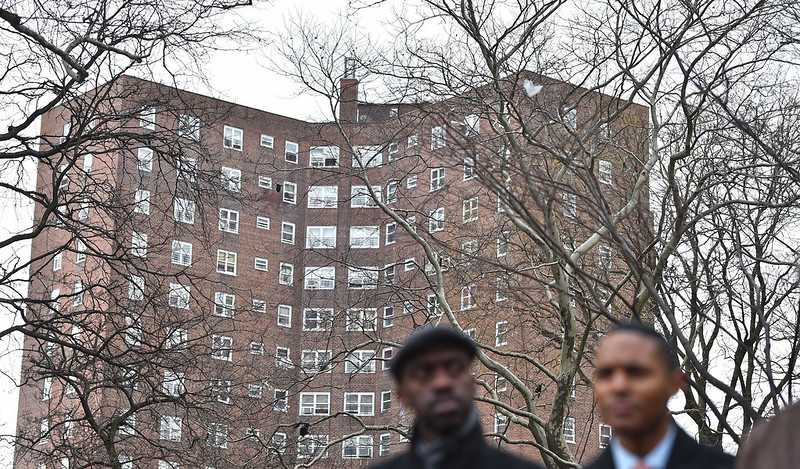
A NYCHA tower looms over a city in crisis (photo: Kevin P. Coughlin/Governor's Office)
In late April, Mayor de Blasio announced a plan to deepen the city’s response to COVID-19 at NYCHA public housing. The plan includes distributing face coverings and gloves to all residents, enrolling all NYCHA senior buildings in the city’s food delivery program, and providing free tablets and internet service for 10,000 senior residents.
It’s long been clear that issues at NYCHA are pervasive, including disgraceful mismanagement of public money and the authority’s crippled system of communication with tenants, which is now more fully showing its limitations. Several weeks after de Blasio’s announcement, NYCHA residents throughout the city were still waiting for components of the plan aimed to support them in this new reality.
NYCHA resident leaders in the South Bronx, for example, have verified that since the hiring of outside contractors they have seen an overall increase in sterilization of their development, however touchpoints like elevators, mailboxes, and door-knobs are not sterilized on a regular basis.
NYCHA’s 2,200 buildings, like the public transit system, senior centers, and other often crowded areas, are potential virus hotspots. It is unacceptable that we do not have widespread testing at NYCHA developments -- an intentional effort by the city is past due.
COVID-19 has hit poor communities, black and brown folks, the hardest across our city. In a post-shutdown city, NYCHA residents must have comprehensive protections against both the virus and the ever-present epidemic of decades-long disregard and disinvestment. NYCHA residents must be afforded ample opportunity for testing and isolation when needed.
According to the Centers for Disease Control, some of the risk factors associated with COVID-19 are age (65 years or older) and conditions including chronic lung disease or moderate to severe asthma. NYCHA tenants regularly report asthma issues and cockroaches, which are an allergen source and an asthma trigger. NYCHA, which has not released a strategy for tracking COVID-19 infection rates, has left residents, building staff, and advocates to highlight the extent of the crisis.
The Housing Authority has bragged about posting updates to their website and social media accounts; sending out emails and alerts through its MyNYCHAapp; posting multilingual fliers in common areas; and scheduling robocalls and in-person outreach. In mid-March, NYCHA said it would start disinfecting its senior buildings five times a week, and all other buildings three times a week. NYCHA residents in East New York, Brownsville, and the South Bronx tell us they haven’t seen this happening with the care (and in some cases the frequency) the Authority has promised.
NYCHA has hired outside contractors to disinfect high-touch areas like elevators, but is still relying on its on-site caretakers to clean the rest of its buildings. The people responsible for keeping housing complexes clean, have themselves been sidelined by unsafe working conditions.
When it comes to the plan released by Mayor de Blasio, which promised PPE to all residents, among other precautions and protections, there has been a disjointed narrative and implementation, necessitating that NYCHA Tenant Association leaders across the city step up when the city has fallen short -- from handing out PPE to meals, NYCHA residents have exemplified a collective will.
Danny Barber, Chair of the Citywide Council of Presidents of NYCHA residents, in partnership with World Kitchen has delivered over 200,000 meals to NYCHA residents and has set a goal to deliver 1 million meals to NYCHA residents throughout the city.
NYCHA tenants in the South Bronx, East New York, Brownsville, and all across our entire city deserve housing that is safe, healthy, and secure. As the current lockdown ends, we will need to ensure that our NYCHA communities have all the resources that they need. A comprehensive post-shutdown NYCHA plan must include:
- COVID-19 testing sites at each NYCHA development
- Food pantry expansion to include a pantry at every NYCHA Community Center
- A NYCHA Residents’ Bill of Rights
- Free wifi for all NYCHA developments
- Development-specific emergency relief plans
- Hazard pay for NYCHA Tenant Associations
- Community-based-organization partnerships to ensure mental health effects of the pandemic are being addressed
Our vulnerabilities have been further exposed by COVID-19. We need to move away from a reactive society to a proactive society. Our leaders must have the political courage to plan for a future where the government both anticipates better and responds more aggressively and efficiently to emergencies, ensuring that our most vulnerable communities are not disproportionately impacted.
***
Wilfredo Florentino is a life-long Brooklynite, community advocate, community board member, and candidate for New York City Council in the 42nd District. Althea Stevens is a native New Yorker and community advocate in the Bronx and candidate for New York City Council 16th District. On Twitter @WilfredoBrooklyn & @Althea_s21.
***
Have an op-ed idea or submission for Gotham Gazette? Email This email address is being protected from spambots. You need JavaScript enabled to view it.
De Blasio’s Empty Words: The Mayor’s Long-Running Failure to Ensure Police Accountability
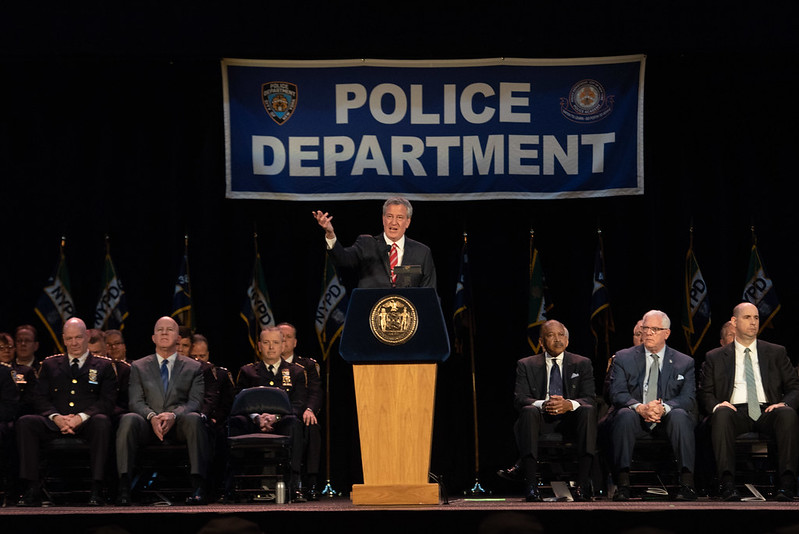
Mayor de Blasio and the NYPD (photo: Michael Appleton/Mayor's Office)
Earlier this week, after nearly six-and-a-half years in office and repeatedly failing to meaningfully and systematically hold his own police department accountable for brutalizing and killing black New Yorkers, Mayor de Blasio took to Twitter to express outrage about Minneapolis police officer Derek Chauvin’s murder of George Floyd.
De Blasio forcefully demanded swift action by authorities in a city half-way across the country. He then proceeded to fail completely to stop police brutality in his own city on Friday and Saturday nights, when black New Yorkers and allies took to the streets to demand justice for Floyd and an end to institutional racism. The NYPD deployed thousands of officers who immediately created a war-like environment and escalated matters, repeatedly initiating violence against community members.
It takes a particular kind of political and moral cowardice to call for justice a thousand miles away while failing to protect black and Latino communities from racist policing in his own city. Martin Luther King Jr. forewarned us about politicians like de Blasio, ”those more concerned with ‘order’ than justice.”
The killing of George Floyd was horrifyingly similar to the NYPD’s killing of Eric Garner. In broad daylight, a police officer choked the life out of a black man on a sidewalk. Cries for help went unheeded by the other officers on the scene.
For more than five years, de Blasio sat on his hands, avoiding any and all responsibility for pursuing discipline or accountability for all officers involved in Eric Garner’s killing. Now former officer Daniel Pantaleo, caught on video choking Garner to death, remained employed by the NYPD for more than five years, even collecting overtime. When the department’s trial revealed egregious misconduct by other officers present, the mayor did all he could to turn the page following the firing of only Pantaleo. Eric Garner’s mother, Gwen Carr, continues to organize and call for all of the officers responsible to be fired. The mayor continues to ignore her calls for accountability and justice.
The murder of Eric Garner is the most high-profile case, but by no means the only time de Blasio spectacularly failed to hold the NYPD accountable for brutalizing and killing black and Latino New Yorkers. Delrawn Small, Jazmine Headley, Saheed Vassell, Sergio Reyes, Kawasaki Trawick -- they may not be as well know as Eric Garner, but their stories are other glaring failures on the part of the mayor to ensure the NYPD is held accountable for brutality and murder. These are only the cases the public hears about. But officers escaping without any discipline for misconduct or brutality, even in cases where people are killed, is the norm not an anomaly.
More recently, during the COVID-19 pandemic, numerous videos of NYPD officers violently enforcing social distancing in black and Latino communities showed the type of violent and biased policing that leads to the deaths of community members like George Floyd, Breonna Taylor, Tony McDade, Eric Garner, Delrawn Small, Saheed Vassell, and many, many others. Police brutality doesn’t take a break for pandemics.
Black and Latino communities have not only suffered because our state and city governments failed to prepare for the disproportionate impact of COVID-19. Mayor de Blasio’s failed approach, where he proactively decided to criminalize a public health crisis before claiming to reverse course, has meant policing enforcement that continued to target our communities.
The mayor has spent much of the pandemic defending and downplaying the NYPD’s discriminatory and dangerous actions, even going as far as victim-blaming black New Yorkers for not following orders and cooperating. A recent video of police brutality during the pandemic shows what easily could have resulted in a similar tragic outcome to George Floyd’s or Eric Garner’s murder. Three weeks ago, following a violent take-down, NYPD officer Francisco Garcia sat on the head and neck of a prone Donni Wright. Wright luckily escaped with his life. De Blasio was much more tempered in his condemnation of the NYPD following that incident and refrained from any calls for swift consequences for the officers involved.
Friday’s night’s numerous incidents of police brutality made the problem even clearer, with officers running amok, beating, pushing, and pepper-spraying New Yorkers. Mayor de Blasio responded with a sad sort of “both sides-ism,” and nothing resembling a true commitment to firing abusive officers and holding the department accountable throughout the chain of command. On Saturday night, after new incidents of blatant policy brutality, the mayor even came to the defense of officers who had driven into protestors with an SUV.
As de Blasio’s second and final term comes to an end, he has cemented his legacy on policing. He was unwilling to hold the NYPD accountable for misconduct and brutality, failed to end “broken windows” policing, and chose to regurgitate talking points about training and neighborhood policing, rather than heeding the calls for justice and meaningful reform. If the mayor is serious about addressing police brutality and valuing all black lives, he should use the remainder of his time in office to pass and support strong legislative reforms to increase police accountability and transparency, while also taking sweeping executive action to change the department that he purportedly controls.
The Mayor should forcefully advocate for full repeal and not a watered down replacement of state Civil Rights Law 50-a in order to make public all police disciplinary records. He should ensure the NYPD swiftly terminates Officer Garcia, all of the officers involved in Eric Garner’s murder, and any officer who abuses their power, including in this week’s protests. And as the city gets closer to finalizing the fiscal year 2021 budget, the mayor should significantly reduce the NYPD budget and headcount and direct cost-savings towards the Department of Youth and Community Development, education, housing, housing the homeless, and social services that keep our communities safe and healthy.
The frustration and outrage manifested in this week’s protests are not merely in solidarity with communities in Minneapolis demanding justice for George Floyd. They are a response to the failure of Mayor de Blasio and decades of previous elected officials who have sanctioned daily state violence against black people in New York. They are the manifestation of generations of black people who have struggled to breathe with the weight of America’s anti-black racism on our necks. Almost six years after Eric Garner’s tragic murder at the hands of the NYPD, we still can’t breathe.
***
Kesi Foster is the Co-Director of the Youth Power Project at Make the Road New York. On Twitter: @BemKesi @MaketheRoadNY.
***
Have an op-ed idea or submission for Gotham Gazette? Email This email address is being protected from spambots. You need JavaScript enabled to view it.
In Our Covid Recovery, A Return to Humanity
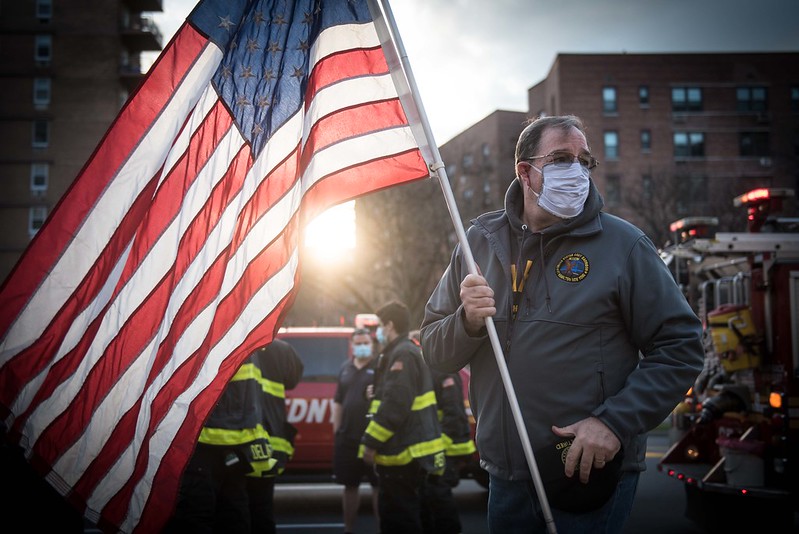
(photo: Michael Appleton/Mayoral Photography Office)
The COVID-19 pandemic has taken so much from us all – over 100,000 lives taken too soon; months spent alone; businesses shuttered forever; and birthdays, proms, goodbyes, graduations, ball games, firsts and lasts missed. It must mean something, but only we can give it meaning through our actions, preparation, kind gestures, and deep love of all that we took for granted, including our shared connection. We have an opportunity to ensure all that we lost was not in vain. As a nation, as a people, we have a solemn obligation to not simply recreate what we had, but to build something better, stronger, more resilient, and more enduring.
We have this immense and meaningful opportunity because of those who took swift action, sacrificed their well-being to serve others, and risked ridicule and failure to save lives and curtail the spread of COVID-19. Their actions to beat back this twisted bunch of RNA undoubtedly mitigated the potential for an even more complete disaster. We owe them a debt of gratitude, but also a new and better normal.
A return to the way things used to be is impossible. We are, as a people, forever changed. Yes, state and federal guidelines for an economic reopening are being implemented in some regions, and we should proceed with these plans based on data, rationale, and the advice of experts, lest we risk going through this experience again. However, reopening is only one piece of the puzzle.
The future is uncertain, but we must be better prepared for the next crisis. For many who confronted COVID-19, it was not an absence of will that kept them from acting as quickly and effectively as possible, but a lack of the necessary tools. Insufficient testing (especially early on), inadequate supply of personal protective and emergency medical equipment, and low levels of health-care capacity are just the most obvious gaps. There were and are more. Data systems and sharing had to be developed and evolved on the fly and many localities had to creatively re-assign staff and rely on volunteers to perform basic levels of contact tracing.
This will not be the last time an infectious disease upturns our lives. To prepare for future challenges, we must increase emergency stockpiles; create supply lines that are more accessible and reliable during periods of global crisis; and streamline regulatory regimes that slowed the approval of needed screening tools and limited innovative solutions. Further, we should generally seek to improve disease surveillance, modernize disease tracking by creating a National Infectious Disease Forecasting Center (as recommended by many, including former F.D.A. Commissioner Dr. Scott Gottlieb), and increase contact tracing capacity by expanding the workforce dedicated to this task and by utilizing app-based technologies.
As a society, we must do more to elevate medical and public health professions and encourage more people to enter these important fields. State governments should look to increase the authority and autonomy of nurse practitioners and physicians’ assistants and permanently reduce restrictions on out-of-state practitioners. Public health professionals should help develop high school curriculums that incorporate specific units on infectious diseases and develop basic public health skills and competencies that could potentially be used on a volunteer basis during a pandemic. All levels of government should work to bolster the ranks of public health service corps and medical reserve corps through tax benefits, recruitment efforts, and increasing paid service roles. As recommended by the “Roadmap to Pandemic Resilience” from Harvard’s Edmond J. Safra Center for Ethics, National Guard units in each state should add Health Reserves Corps.
Much has been lost and foregone over these months. It would have been easy during this time to lose our connection to one another, but in so many ways that connection deepened. Health-care professionals and first responders, including those who came out of retirement, consistently put the well-being of their patients before their own. People from all walks of life went to work making masks, gathering supplies, delivering meals, and caring for others. Tens of millions of dollars were donated to support COVID-19 response and relief efforts. Neighbors sang in the streets; teachers adapted on the fly to a new paradigm; friends and families celebrated milestones with impromptu parades and honking horns; and millions of individuals stayed at home and stopped the spread.
Sadly, there was no permanent cessation of political jabbing, name-calling, and anger. However, there were plenty of positive lessons to be learned. Experts and expertise seemed to regain the public’s and some political leaders’ reverence. The critical role of federalism in our republic was highlighted by the swift and well-thought-out actions of many governors, while the benefits of localism were clear, given the creativity and proactiveness of counties throughout New York and the nation. My experience during this emergency has been one of practical and congenial bipartisanship, not the mudslinging you see on the national news.
And yet the most important lesson is not about politics but people. It is about how important our shared connection is to our overall well-being. It is also about this opportunity to glimpse, if only briefly, the lives of those less fortunate – those who face food insecurity every day, those who live paycheck to paycheck, and those who face crippling anxiety and fear of the world outside their doors.
When we create our new normal, let us not forget those lessons. Let our recovery herald in a return to a better humanity in which we cherish those connections we have and work to form stronger bonds with our wider community. Let us return to a better humanity that takes care of those less fortunate by providing a strong safety net to catch those who have fallen through the cracks and that offers a sturdy ladder to aid in the climb to prosperity.
The world has changed, and we must change with it, if for no other reason than that we owe all those lost and all who lost, sacrificed, and worked so hard a better world, a new normal. We owe them a return to a stronger, healthier, and more connected humanity.
***
Marc Molinaro is the Dutchess County Executive. On Twitter @MarcMolinaro.
***
Have an op-ed idea or submission for Gotham Gazette? Email This email address is being protected from spambots. You need JavaScript enabled to view it.
The Case for Touchless Interface Technologies in a Post-COVID-19 World
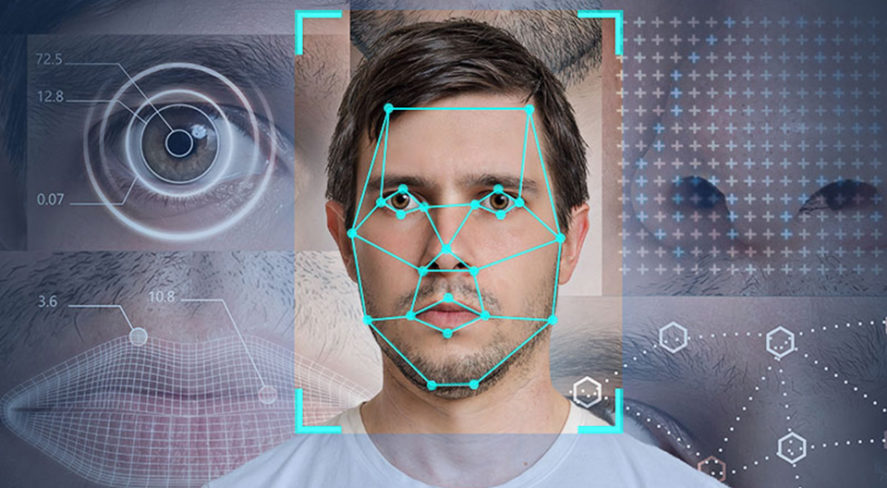
Facial recognition could be useful in the post-coronavirus world (photo: Security Industry Association)
As a native New Yorker, I am saddened that New York has been hardest hit by the COVID-19 virus. The very way of life for New Yorkers – close living and working conditions, reliance on a round-the-clock crowded mass transit system, a vibrant restaurant and bar scene, movie and live performance theaters, national and international transportation hubs, sporting facilities with tens of thousands of seats and over a million children in the public school system – has made the region particularly vulnerable to the novel virus.
We must be real about how long this disease will be with us, its lethal nature and how it has changed our lives. We must also be real about what steps we take to mitigate the impact of COVID-19, both through informed policies and through deployment of the right technologies that can help prevent the spread of this and other infectious diseases in the future.
Support is growing for touchless interactions, to protect the most vulnerable in our communities and our essential workers. Touchless solutions for access or screening required for entry to an area could be game-changers in reducing the spread of the virus and improving public safety.
These solutions can range from relatively low-tech ones like wave-to-open switches, motion sensors, and wireless transmitters to technologies developed to address more complex needs. Many hospitals already use facial matching technology to eliminate the need for frontline health care workers to swipe badges or type in codes to verify their credentials. By simply showing their faces, they are allowed access to clean rooms and other secure facilities. Reducing contact with potentially contaminated surfaces is critical to prevent our health care heroes – who are putting their lives on the line to help others – from becoming infected.
Programming an automatic building or elevator door to open for users would eliminate thousands of touches per day by human fingers and hands. In addition, facial matching technology can ensure that only authorized individuals are permitted to enter a building or workspace. For commercial buildings, thermal technologies can help initially screen entrants at a distance for elevated body temperature, identifying those who may need further testing before potentially exposing coworkers and others to the virus.
As people begin to travel by planes, trains, or buses at any of New York’s major transportation hubs, they will need to pass through security checkpoints, exchange documents with officials, and sit in closed, cramped spaces with scores of strangers. Touchless technologies can decrease the risk of spreading the virus and increase overall passenger safety. For example, New York’s John F. Kennedy International Airport uses facial matching technology to provide touchless security and allow some international travelers to board flights without exchanging boarding passes.
Despite these benefits, some cities have attempted to limit facial matching and other biometric-based or electronic security technologies, even banning their use altogether. In New York, members of the City Council have proposed making it much more difficult for biometric technologies to be deployed for building access and security, and even mandate the use of physical keys in places where they were phased out in favor of electronic systems decades ago. Such restrictions would prevent proven and tested technologies from being used to protect the health and safety of New Yorkers.
Concerns about facial matching technology have garnered much media attention over the last year. Contrary to popular misconceptions, the accuracy of this technology is in fact reaching that of automated fingerprint comparison, which is generally viewed as the gold standard for identification. The National Institute of Standards and Technology (NIST), the world’s leading authority on facial matching technology, has concluded that the software it tests is 20 times better at searching a database to find a matching picture than it was in 2014, and a NIST report last year recorded “close to perfect” results with miss rates averaging just 0.1 percent for the most accurate systems.
Advanced technologies like facial matching offer ready, touchless solutions to many of the challenges we will face in a post-COVID-19 world, which must be implemented in ways that respect privacy while also allowing our society to use science and innovation to be healthier and safer as we seek a return to a more normalized life. The Security Industry Association believes that all technology products must only be used for purposes that are lawful, ethical, and nondiscriminatory. If we work together and embrace it, touchless interface technologies can be one of our formidable frontline defenses to help reduce the spread of COVID-19 and other deadly diseases.
***
Don Erickson is CEO of Security Industry Association. On Twitter @SIAonline.
***
Have an op-ed idea or submission for Gotham Gazette? Email This email address is being protected from spambots. You need JavaScript enabled to view it.




